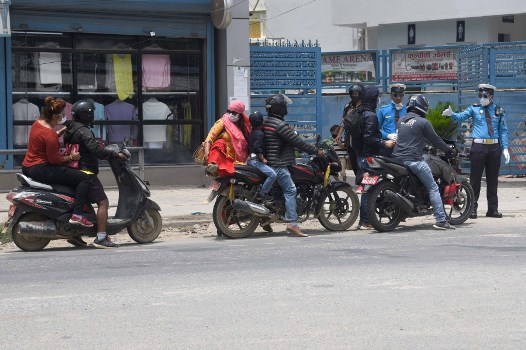Odd-even rule may be increasing crowd in vehicles

By A Staff Reporter
Kathmandu, Nov. 7: The odd-even rule for the vehicles -- both private and public -- took effect in the Kathmandu Valley on September 10.
The District Administration Office of the Valley had brought this rule as a significant measure to combat COVID-19 pandemic.
Despite the introduction of that rule, the pandemic has aggravated.
Two months into its implementation, no other measures have been taken to make it manageable and to not hamper the livelihoods of the people.
The Metropolitan Traffic Police Division, Ramshahpath, has been detaining scores of vehicles violating the rule on a daily basis.
Chief of Division Senior Superintendent of Traffic Police (SSP) Bhim Prasad Dhakal said that they are simply implementing the decision taken by the government.
He said, “We have been doing our job by rule.”
A senior security official at the Police Headquarters said, “There is no justification for implementing the system. Are COVID-19 cases coming under control in Kathmandu because of this rule?”
“The risk, however, has increased further as only a few vehicles ply on the road. When the number of vehicles is limited, crowding among the passengers increases, so the government must be serious,” he suggested.
Former AIG Nabaraj Dhakal of Nepal Police said that it is time to reconsider the rule and that instead of enforcing the now-useless rule, the government should find viable alternatives.
“Citizens have now become aware of the risk. Since most of them have lost their jobs, a very few of them wish to travel by taxi, bus, or other means of public transportation. The rule, therefore, must be reviewed now,” he said
Ever since the measures were taken, quite a few people have been facing difficulty in their daily activities, forcing them to choose alternative means.
Kumar Shrestha, a local from Kirtipur, said that dozens of people in the Valley were suffering because of that rule and that police stopped the vehicles even while travelling to work and drivers as well as passengers had faced unnecessary hassles.
“Social distance is not observed in public transport. There are passengers in all the seats,” Shrestha said.
Motorcycles are the most widely used means of transportation.
After the rule came into effect, only a limited number of vehicles are seen on the roads. But those who have to go to work daily at any cost should be given a free pass.
“Passengers are forced to use public transport like microbus even if they are packed with passengers and this has been happening due to the unavailability of sufficient public vehicles,” Manju Prajapati, who works in a private firm in New Road and has to travel to Jadibuti, near Koteshwar every day, said.
She is of the opinion that the pressure on the commuters traveling by public vehicles will be less, as will the risks, if all the vehicles start plying.
Janak Raj Sapkota, CDO of Kathmandu, however, has a different view. He claimed that the rule has been helping -- in one way or another -- to reduce the number of cases. “We cannot lift this rule for now,” he said.
Recent News

Do not make expressions casting dout on election: EC
14 Apr, 2022
CM Bhatta says may New Year 2079 BS inspire positive thinking
14 Apr, 2022
Three new cases, 44 recoveries in 24 hours
14 Apr, 2022
689 climbers of 84 teams so far acquire permits for climbing various peaks this spring season
14 Apr, 2022
How the rising cost of living crisis is impacting Nepal
14 Apr, 2022
US military confirms an interstellar meteor collided with Earth
14 Apr, 2022
Valneva Covid vaccine approved for use in UK
14 Apr, 2022
Chair Prachanda highlights need of unity among Maoist, Communist forces
14 Apr, 2022
Ranbir Kapoor and Alia Bhatt: Bollywood toasts star couple on wedding
14 Apr, 2022
President Bhandari confers decorations (Photo Feature)
14 Apr, 2022










